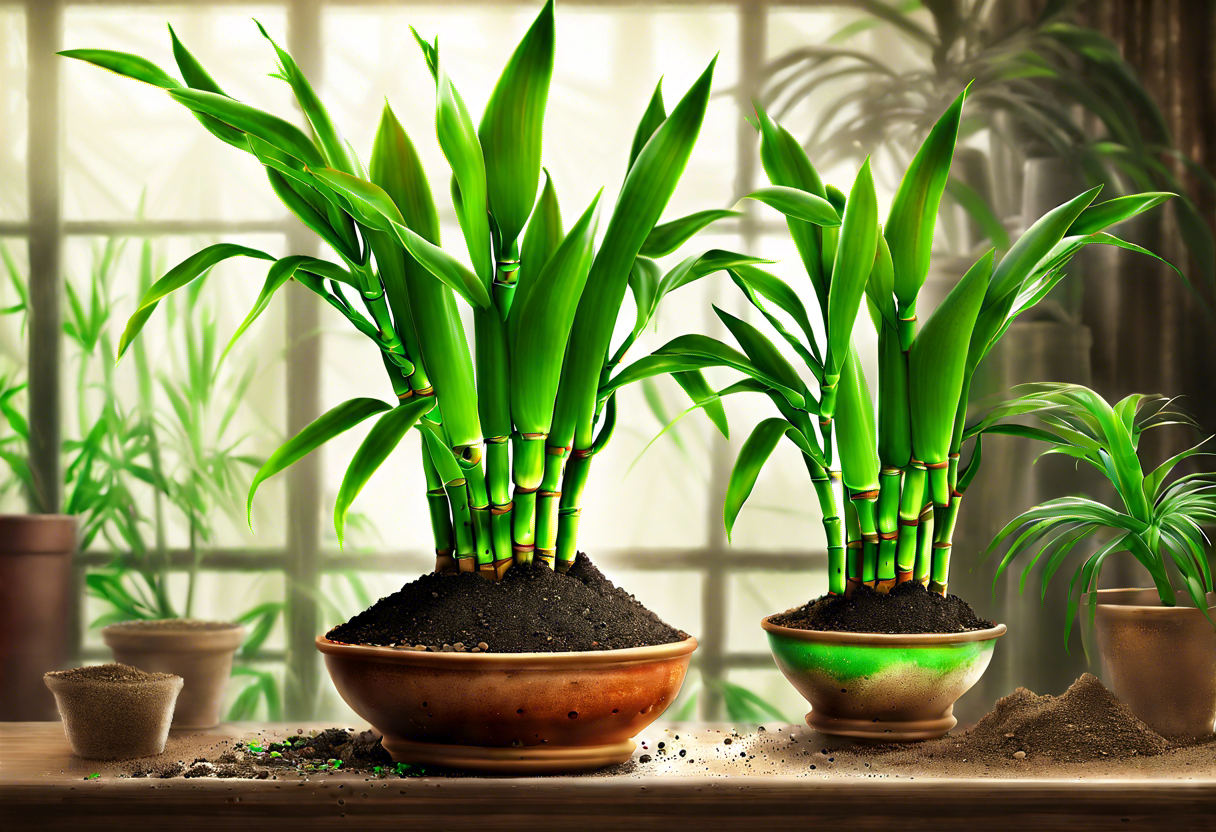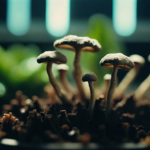The Importance of Choosing the Right Soil or Potting Mix for Lucky Bamboo
When it comes to indoor plants, lucky bamboo (Dracaena sanderiana) is a popular choice due to its elegant appearance and reputation as a bringer of good luck. However, to ensure that your lucky bamboo thrives and remains healthy, it is crucial to choose the right soil or potting mix. The proper soil will provide the necessary nutrients, moisture retention, and aeration that the plant needs to flourish.
Lucky bamboo is not actually bamboo; it is a member of the Dracaena family. Unlike true bamboo, it does not require a specific type of soil. Lucky bamboo can grow in a variety of soil types, as long as they meet certain characteristics. The key is to select a soil or potting mix that promotes proper drainage and aeration while retaining enough moisture to keep the plant hydrated.
One crucial factor to consider when choosing soil for lucky bamboo is its water retention abilities. This plant prefers slightly moist soil but does not tolerate waterlogged conditions. A well-draining soil mix that allows excess water to escape is essential to prevent root rot and other water-related problems. Sandy loam or a mix consisting of equal parts of peat moss and perlite are excellent choices, as they provide adequate drainage and moisture retention.
Another consideration is the nutrient content of the soil. Lucky bamboo doesn’t have high nutrient requirements, but providing it with a balanced soil mix can promote healthy growth and vibrant foliage. A good option is a well-balanced potting mix designed for houseplants. These mixes usually contain a combination of organic matter, such as compost or peat moss, along with essential minerals and nutrients.
In addition to the right soil mix, you can enhance the growth of lucky bamboo by incorporating a slow-release fertilizer. This will provide a steady supply of nutrients over an extended period. However, use caution and do not over-fertilize, as this can lead to salt build-up or root burn. Always follow the fertilizer package instructions and apply it sparingly.
When potting your lucky bamboo, it is essential to choose a pot that has drainage holes to prevent water from accumulating at the bottom. Ensure that the pot is large enough to accommodate the plant’s roots comfortably and provide room for growth. Transplanting into a bigger pot every one or two years is also recommended to prevent overcrowding.
Choosing the right soil or potting mix for your lucky bamboo is essential for its overall health and growth. Opting for a well-draining mix that retains moisture, along with balanced nutrient content, will provide the ideal environment for your plant to flourish. By taking care of the soil needs of your lucky bamboo, you can enjoy its beauty and positive energy for years to come.
Understanding the Specific Soil Needs of Lucky Bamboo
When it comes to caring for Lucky Bamboo (Dracaena sanderiana), choosing the right soil or potting mix is crucial for its overall health and growth. Lucky Bamboo is a popular indoor plant known for its resilience and ability to thrive in a variety of environments. However, to ensure optimal growth and longevity, it is important to understand its specific soil needs.
Lucky Bamboo is not actually bamboo, but rather a member of the Dracaena family. It is native to rainforests in Southeast Asia and primarily grows in the understory of dense forests. As a result, it has adapted to thrive in soils that are rich in organic matter and provide good drainage.
When choosing a soil or potting mix for Lucky Bamboo, it is essential to select one that replicates its natural habitat as closely as possible. A well-draining soil mix that retains moisture without becoming waterlogged is ideal. This will prevent the roots from sitting in excessive moisture, which can lead to root rot and other issues.
One effective soil or potting mix option for Lucky Bamboo is a combination of peat moss and perlite or vermiculite. Peat moss provides moisture retention while allowing excess water to drain, while perlite or vermiculite improves soil aeration and prevents compaction. This combination creates a well-balanced soil mix that promotes healthy root development and growth.
Another option is to use a commercially available potting mix specifically formulated for indoor plants. Look for a mix that is labeled as suitable for houseplants or tropical plants. These potting mixes are often composed of a blend of organic matter, such as peat moss, coconut coir, or bark, along with the necessary ingredients for proper drainage.
It is important to note that Lucky Bamboo can also be grown in water, eliminating the need for soil altogether. In this case, using distilled or filtered water is recommended to prevent the buildup of minerals. Additionally, it is crucial to change the water regularly to maintain its cleanliness and avoid the growth of algae.
Understanding the specific soil needs of Lucky Bamboo is essential for its overall health and well-being. Whether choosing a soil or potting mix or opting for water cultivation, it is crucial to provide the right environment for this versatile plant to thrive.
The Importance of Choosing the Right Soil or Potting Mix for Lucky Bamboo
In order to ensure the health and well-being of your Lucky Bamboo (Dracaena sanderiana), it is crucial to choose the right soil or potting mix. This tropical plant, which is popularly known for its resilience and symbolism of good fortune, has specific soil requirements that must be met to thrive.
Lucky Bamboo is not a true bamboo; it belongs to the Dracaena family. This plant prefers to grow in a loose, well-draining soil that retains moisture but does not become waterlogged. Using the wrong soil or potting mix can lead to poor growth, root rot, and even the death of the plant.
When selecting soil or potting mix for your Lucky Bamboo, there are several factors to consider.
1. Drainage
One of the most important factors is the soil’s ability to drain excess water. Lucky Bamboo roots are susceptible to rot if they sit in water for too long. It is recommended to choose a soil or potting mix that provides good drainage to prevent waterlogging.
2. Moisture Retention
While good drainage is essential, Lucky Bamboo also requires a soil or potting mix that retains moisture. This plant prefers moderately moist soil, so it’s important to strike the right balance. A soil mix that readily releases excess water while retaining enough moisture is ideal.
3. Nutrient Content
Another consideration is the nutrient content of the soil or potting mix. Lucky Bamboo benefits from a well-balanced fertilizer and nutrient-rich soil. Look for a mix that contains organic matter or add a slow-release fertilizer specifically formulated for houseplants.
4. pH Level
Lucky Bamboo prefers a slightly acidic to neutral pH level. The ideal range is between 6.0 and 7.0. Testing the pH level of the soil or potting mix can help ensure a suitable environment for your plant.
Considering these factors, there are a few soil or potting mix options that are best suited for Lucky Bamboo:
1. Peat-based Potting Mix
A peat-based potting mix is an excellent choice for Lucky Bamboo as it provides good drainage while retaining sufficient moisture. It also offers a slightly acidic environment, which is favorable for the plant.
2. Orchid Mix
An orchid mix is another suitable option for Lucky Bamboo. It consists of materials like bark, perlite, and moss, allowing for excellent drainage. This mix also retains moisture, promoting healthy root growth.
3. Well-Draining Garden Soil with Sand
If using garden soil, ensure it is well-draining by incorporating sand or perlite. This helps prevent waterlogging and creates an optimal growing environment for Lucky Bamboo.
Selecting the right soil or potting mix for your Lucky Bamboo is crucial for its overall health and growth. Consider factors such as drainage, moisture retention, nutrient content, and pH level when making your choice. Potting mixes like peat-based mixes, orchid mixes, or well-draining garden soil with sand are ideal options to provide a suitable environment for your Lucky Bamboo to thrive.
Best Soil or Potting Mix Options for Lucky Bamboo (Dracaena sanderiana)
When it comes to growing healthy and vibrant Lucky Bamboo (Dracaena sanderiana), choosing the right soil or potting mix is essential. This popular houseplant requires a growing medium that provides adequate support, drainage, and nutrients for optimal growth. In this article, we will explore some of the best soil or potting mix options for Lucky Bamboo, ensuring your plant thrives in its new environment.
-
Well-Draining Soil: Lucky Bamboo prefers soil that drains well to prevent waterlogged roots, which can lead to root rot and other health issues. A mixture of regular potting soil and pumice or perlite can provide the ideal drainage conditions. These additives lighten the soil and enhance its aeration, allowing excess water to move through the roots without causing damage.
-
Peat Moss-Based Mix: Another excellent option for Lucky Bamboo is a potting mix that contains peat moss. Peat moss helps retain moisture while also preventing the soil from becoming overly saturated. It provides a well-balanced environment for the plant’s roots, allowing them to access water and nutrients as needed.
-
Orchid Mix: Lucky Bamboo can also thrive in an orchid mix, which typically consists of a combination of fir bark, sphagnum moss, and perlite or other additives. This mixture replicates the epiphytic growing conditions that orchids prefer. The airy nature of the orchid mix ensures excellent drainage and aeration, promoting healthy root growth.
-
Aquatic Plant Soil: If you prefer to grow Lucky Bamboo in water rather than soil, an aquatic plant soil can be used to provide stability for the plant. These soils are specially formulated to support the growth of aquatic plants like Lucky Bamboo. They typically consist of a mixture of clay, sand, and other organic materials to provide the necessary nutrients.
-
DIY Soil Mix: For those who prefer to create their own potting mix, a combination of equal parts peat moss, perlite, and orchid bark can be an excellent choice. This mixture offers a well-draining, nutrient-rich environment that promotes optimal growth and health for Lucky Bamboo plants.
Remember to repot your Lucky Bamboo every 1-2 years to ensure it has adequate space to grow and access to fresh soil or potting mix. Additionally, always water your Lucky Bamboo with distilled or filtered water to avoid chlorine or other harmful minerals present in tap water.
Selecting the best soil or potting mix for your Lucky Bamboo is crucial for its overall health and growth. Whether you prefer a well-draining soil mix, peat moss-based mix, orchid mix, aquatic plant soil, or a DIY soil mix, the key is to provide a growing medium that offers adequate drainage, aeration, and nutrients. By choosing the right soil, you can create the ideal conditions for your Lucky Bamboo to flourish and bring a touch of natural beauty to your home or office.
Successful Potting and Soil Management for Lucky Bamboo
Growing and caring for lucky bamboo (Dracaena sanderiana) can be a rewarding experience, but it requires attention to detail, especially when it comes to potting and soil management. The right soil or potting mix plays a vital role in the overall health and growth of your lucky bamboo. Here are some essential tips to ensure successful potting and soil management for your lucky bamboo.
1. Choosing the Right Container: Selecting an appropriate container is the first step towards successful potting. Lucky bamboo can thrive in both soil and water-based environments. If you prefer soil, choose a container that has good drainage holes to prevent waterlogging.
2. Well-Draining Soil: Lucky bamboo requires a well-draining soil mix that retains enough moisture without becoming waterlogged. Avoid heavy clayey soils that hold too much water, as they can lead to root rot. Instead, opt for a lightweight soil mix that includes ingredients like peat moss, perlite, and sand.
3. pH Level: Lucky bamboo prefers slightly acidic to neutral soil conditions, with a pH range between 6 to 7. Regularly test the pH level of your potting mix using a pH testing kit available at garden centers. Adjust the pH level by adding organic matter or soil amendments if necessary.
4. Moisture Retention: While lucky bamboo needs well-draining soil, it also requires consistent moisture. Avoid letting the soil completely dry out between watering sessions. Monitor the moisture content by inserting your finger about an inch into the soil. If it feels dry, it’s time to water your plant.
5. Fertilization: Lucky bamboo is a relatively low-maintenance plant, but it does benefit from occasional fertilization. Use a balanced liquid fertilizer specifically formulated for houseplants, diluted to half the recommended strength. Apply the fertilizer once every two months during the growing season.
6. Repotting: As your lucky bamboo grows, it may outgrow its current container. Repotting is necessary to provide room for its roots to expand. Replant your lucky bamboo into a slightly larger container with fresh potting mix every two to three years.
7. Avoid Overcrowding: Overcrowding multiple lucky bamboo stalks in a single container can inhibit their growth and lead to nutrient deficiencies. Allow enough space between each stalk to promote proper air circulation and ensure each plant receives adequate light and nutrients.
8. Cleanliness: Keeping your potting mix and container clean is crucial for preventing the buildup of harmful bacteria or fungi. Regularly inspect the soil for any signs of mold or pest infestation. If necessary, remove the affected soil and replace it with fresh, sterile potting mix.
By following these tips for successful potting and soil management, you can provide your lucky bamboo with an optimal growing environment. Remember to observe your plant closely and make adjustments as needed, ensuring its health and longevity. With the right soil and proper care, your lucky bamboo will thrive and bring you joy for years to come.
Conclusion
Choosing the right soil or potting mix for your lucky bamboo (Dracaena sanderiana) is vital for its overall health and growth. Lucky bamboo is a unique and popular indoor plant that requires specific soil conditions to thrive. By understanding its specific soil needs and considering various factors, you can select the best soil or potting mix to ensure the well-being of your lucky bamboo.
Lucky bamboo prefers loose, well-draining soil that holds moisture without becoming waterlogged. It requires a mix that provides adequate aeration to the roots and allows excess water to drain away. Using heavy soils or those that retain water can lead to root rot and other problems.
When selecting a soil or potting mix for lucky bamboo, consider factors such as porosity, organic matter content, and pH level. Porous soils promote air circulation, allowing the roots to breathe and preventing waterlogged conditions. An ideal mix consists of a combination of peat moss, perlite, and fine sand, which provides good drainage and aeration.
Another crucial factor to consider is the organic matter content of the soil or potting mix. Lucky bamboo benefits from soil enriched with organic matter, such as compost or well-rotted manure. Organic matter improves water retention capacity and enhances nutrient availability, promoting healthy growth.
Maintaining the appropriate pH level is also essential. Lucky bamboo thrives in slightly acidic to neutral soils, with a pH range of 6 to 7. Adjusting the pH level with the addition of organic material or pH-adjusting agents can maximize the plant’s nutrient absorption and overall health.
Some recommended soil or potting mix options for lucky bamboo include a mix of equal parts peat moss, perlite, and fine sand. This combination offers excellent drainage, aeration, and moisture retention. Alternatively, you can use a commercial potting mix designed specifically for indoor plants.
To ensure successful potting and soil management for lucky bamboo, consider a few tips. When repotting or transitioning from water to soil, gently remove excess water from the roots and trim any damaged or mushy roots. Plant the bamboo in a sufficiently sized container, ensuring sufficient space for root growth.
Ensure regular watering, keeping the soil moist but not waterlogged. Lucky bamboo prefers filtered or distilled water rather than tap water, which may contain high levels of chlorine, fluoride, or other chemicals harmful to the plant. Additionally, fertilize your lucky bamboo sparingly to avoid overfeeding and causing nutrient imbalances.
Selecting the best soil or potting mix for your lucky bamboo is crucial for its overall well-being. By understanding its specific soil needs, considering key factors, and adhering to proper potting and soil management techniques, you can provide your lucky bamboo with an optimal growing environment. With the right soil, your lucky bamboo will thrive, bringing beauty and luck to your indoor space for years to come.


